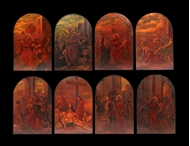![]() Traditional, Modern & Contemporary Indian Art
Traditional, Modern & Contemporary Indian Art
![]() Traditional, Modern & Contemporary Indian Art
F N SOUZA (1924 - 2002)
Traditional, Modern & Contemporary Indian Art
F N SOUZA (1924 - 2002)
RELATED LOTS
-
Provenance
 Provenance
Provenance
Illustrated in F.N Souza - Words & Lines, published in 1959
Acquired by the collector, at the suggestion of M.F Husain, thence by descent in his family.
-
Literature
 Literature
Literature

"An artist can't become, he is born. The artist is in the foetus; the creative principle begins in the womb. I remember painting murals on the walls of my mother's womb."
- Francis Newton SouzaThe present works (lot 21 and 22), are a set of exceptional drawings by Francis Newton Souza, the founding member of the Bombay Progressive Group and considered to be the pioneer of Modern Indian art. The works were created between 1952 - 59, a time when he was living in London, a city that was still recovering from the devastations of the Second World War. Souza had started getting some recognition for his work since the early 1950s. His works had been exhibited at the Indian Embassy in London (1951), the Institute of Contemporary Arts - London (1954) and the Venice Biennale in Italy (1954). His breakthrough however came in 1955, with the aide of his exceptional literary talent that was revealed in the ground-breaking autobiographical work 'Nirvana of a Maggot' and published in Encounter - a journal edited by Stephen Spender. This was followed by a very successful exhibition (and subsequent others) at Gallery One in London. Later his book 'Words and Lines' published in 1959 established his reputation as an artist and literary figure of eminence.
Souza's art steered away from conventions and banality, overpowering the viewer with their dusky and macabre overtones. His valiant defiance and destruction of the ordinary, surfaces in predictable recurrence in his biography, reiterating sequences of death, creation, endeavour and failure. His preoccupation with figurative art does not necessarily stem from the cause of imparting a social message or moral insinuation. He strongly believed that an artist primarily creates art for the appeasement of his inner soul. Therefore in a society burdened with gargantuan organizational systems, devouring its humans in the name of cast, creed and ideology, he drove to assert himself in defiant sovereignty. As John Berger pointed out, his style was 'deliberately eclectic: essentially Expressionist in character, but also drawing on the post-war Art Brut movement and elements of British Neo-romanticism.
Critics Edwin Mullins and David Sylvester compared Souza's expressionism with that of Graham Sutherlandand Francis Bacon, both of whom had depicted religioussubject matter in a similarly brutal style shortly after theSecond World War. Comparisons were also drawn withthe stylistic renditions of artists like Georges Rouault and Pablo Picasso (1930s-40s). The true roots of Souza's art however lay entrenched in the stylistic variations of Rouault and Picasso as much as in the Spanish and Portuguese imagery of the Byzantine era. Much of his art retains thestiff, hieratic quality of Byzantine church imagery.
As a child, Souza was fascinated by his grandmother'sstories of angels and tortured saints. His young mind lingered in pre-occupied musings of the phantasmagorias,angels of paradise and into hallucinating conversations with ghosts, saints, fairies and goblins. The Roman Catholic Church allured him, more so by its grand architecture and impressive services, than by its cannons of faith. Souza recounts 'The priest dressed in richly embroidered vestments.... the wooden saints painted in gold and bright colours staring vacantly out of their niches, smell of incense and the enormous crucifix with the impaled image of a Man supposed to be the Son of God, scourged and dripping, with matted hair tangled in plaited thorns. I would kneel and pray for hours."




